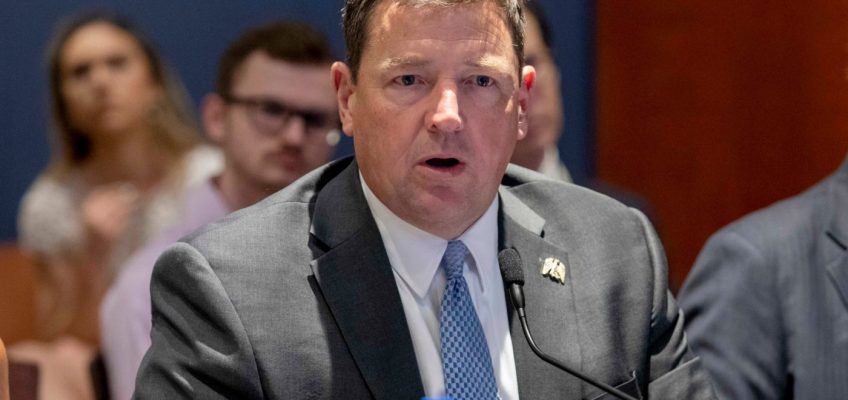What do the Wabasha Street Caves, Cafe Latte and the Twin Cities German Immersion School have in common? They’re all featured in “Monopoly: St. Paul Edition.”
After suggestions from locals and a tour of the city by Mr. Monopoly himself, the St. Paul edition of the 90-year-old beloved board game was unveiled to a select crowd Thursday night in St. Paul.
“This edition has become more than just a game,” said Tim Barney, a representative for game-maker Top Trumps USA. “It’s a love letter to St. Paul — showcasing everything from your cherished parks and cultural treasures, to unique flavors, history and creativity that make your community so special.”
Also in attendance for the grand reveal was St. Paul Mayor Melvin Carter and Mr. Monopoly, with the latter strutting the stage to “For The Love of Money” by The O’Jay’s.
Carter, whose go-to game piece is the running shoe, said, “I think the one thing St. Paul didn’t have is our own Monopoly game. But we got that all taken care of.”
Board game specs
Starting at “Go,” players will move through lower ticket items on the game board like Mears Park and the Como Park Zoo and Conservatory toward the St. Paul Winter Carnival.
Local businesses spotlighted on the board include Boca Chica, Can Can Wonderland, St. Paul Brewing, Hmongtown Marketplace and Anchor Paper Company. Blaze Credit Union, whose logo appears on the Monopoly money, also collects from the income tax and luxury tax spaces on the board.
Several properties came as no surprise including the Science Museum of Minnesota and the Minnesota State Capitol.
One potentially controversial property that made the board is the Minnesota State Fair. Clearly a point of pride for Minnesotans, the controversy could lie in the address, which is Falcon Heights, a suburb, not St. Paul.
The board of the St. Paul edition of Monopoly during a reveal party at CanCan Wonderland in St. Paul on Thursday, Aug. 14, 2025. (John Autey / Pioneer Press)
The largest ticket items on the board — traditionally reserved for Park Place and Boardwalk — have been upgraded to CHS Field, the home of the St. Paul Saints, and the most expensive property on the board is the Cathedral of St. Paul.
Where the original board had train stations, the St. Paul version boasts a variety of transportation methods including the Mississippi River, the Minnesota Transportation Museum, the Skyway Bridge and Union Depot.
In place of the standard “electric” and “water” utilities that are charged according to the roll of the dice, are hyperlocal utilities. All Energy Solar, a St. Paul energy company claims one space, and the other is the Highland Park Water Tower, a fixture of the St. Paul Regional Water Service and a suggestion given by a reader of the Pioneer Press’ Morning Report.
Hidden gems
Perhaps the best part of the game lies in the Community Chest and Chance cards which are full of surprises that St. Paulites will appreciate.
One Community Chest card awards a player for making the best hotdish at the potluck.
“Dancing with danger! Public enemy number one, John Dillinger, has been spotted dancing at the premier Wabasha Street Caves!” reads a Chance card that advances the player.
The board of the St. Paul edition of Monopoly during a reveal party at CanCan Wonderland in St. Paul on Thursday, Aug. 14, 2025. (John Autey / Pioneer Press)
“You just won the eyeball race by diving across the toilet paper finish line at the St. Paul Saints game. Collect $100,” reads another Community Chest card. One such card even references the historic Halloween blizzard of 1991.
Want to play?
The public is invited to join in on the celebration Friday at St. Paul Brewing, located at 688 E. Minnehaha Ave. The free event starts at 6 p.m.
Related Articles
Judge orders Lake Elmo mother to be released after immigration arrest
Expect to be hearing more planes overhead: MSP airport runway work resumes
Woman shot in St. Paul while daughter, 2, was in backseat says ‘mom mode’ took over
St. Paul woman dies in water emergency at Lake Vermilion
Dining Diary: Salads at Holman’s Table, pasta at DeGidio’s and sandwiches at Due and Cloverleaf
“We appreciate all those who suggested landmarks, organizations and businesses that make St. Paul unique and truly special,” Barney said in a news release.
Top Trumps USA — the Rhode-Island based game company behind this Hasbro-authorized edition — has also put out Detroit, Nashville, Tenn.; Tampa, Fla., and Portland, Ore., editions of Monopoly.
By the way, the company’s Top Trumps name does not refer to President Donald Trump, in case you were wondering; “Trumps” is the name of a card game that is well known in the United Kingdom — and a pack will be included in the board game as an (unrelated) bonus, Barney said.
“Monopoly: St. Paul Edition” can be purchased online or in St. Paul at Can Can Wonderland, Café Latte, Wabasha Street Caves, Hmongtown Marketplace and Union Depot, to name a few.




